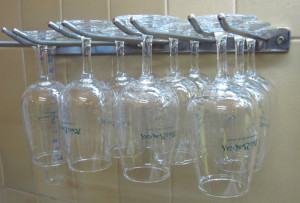Taste and taste again
March 9th, 2014 | Tasting
 It’s probably fair to say that there’s not much happening in the Bodega at this time of year. Of course our team are busy out in the vineyards, as they approach the end of the pruning – and I should add that this year in particular, they deserve a medal. Pruning can be a backbreaking job at the best of times, but with torrential rain nearly all winter, this year has been a nightmare for them. Please don’t forget that with our pergola training system to prune overhead vines means facing skyward – imagine all that rain beating down directly into your face!
It’s probably fair to say that there’s not much happening in the Bodega at this time of year. Of course our team are busy out in the vineyards, as they approach the end of the pruning – and I should add that this year in particular, they deserve a medal. Pruning can be a backbreaking job at the best of times, but with torrential rain nearly all winter, this year has been a nightmare for them. Please don’t forget that with our pergola training system to prune overhead vines means facing skyward – imagine all that rain beating down directly into your face!
Meanwhile, back in the cellar, one of the most important, ongoing jobs that we do, is tasting the tanks. Our 2013 albariños are all still lying, undisturbed on their lees and have to be monitored at very regular intervals. When we age our wines on the lees, there is absolutely no hard and fast rule as to how long this process should take – normally it will be a minimum of at least 5 months, but this can actually be much longer, depending on the wine and the vintage. The object of tasting is to ensure that the lees are clean and not tainted – we are really looking for any signs of ‘reduction’ caused by the sulphur compounds that are formed in the wine during fermentation. Once the available nitrogen in a must or grape juice is exhausted, the yeast will break down and form compounds such as hydrogen sulphide, which we all know as ‘bad egg gas’. Apart from the eggs, a vast number of different sulphur compounds can taint a wine with all manner of unappealing characteristics such as onion, garlic, cabbage and burnt rubber, which is why we have to keep a sharp eye (or keen nose) to make sure that the wine remains clean. We then chose the optimum moment to ‘rack’ the wine into clean tanks, discarding the unwanted yeast deposits.
 It’s probably fair to say that there’s not much happening in the Bodega at this time of year. Of course our team are busy out in the vineyards, as they approach the end of the pruning – and I should add that this year in particular, they deserve a medal. Pruning can be a backbreaking job at the best of times, but with torrential rain nearly all winter, this year has been a nightmare for them. Please don’t forget that with our pergola training system to prune overhead vines means facing skyward – imagine all that rain beating down directly into your face!
It’s probably fair to say that there’s not much happening in the Bodega at this time of year. Of course our team are busy out in the vineyards, as they approach the end of the pruning – and I should add that this year in particular, they deserve a medal. Pruning can be a backbreaking job at the best of times, but with torrential rain nearly all winter, this year has been a nightmare for them. Please don’t forget that with our pergola training system to prune overhead vines means facing skyward – imagine all that rain beating down directly into your face!
Meanwhile, back in the cellar, one of the most important, ongoing jobs that we do, is tasting the tanks. Our 2013 albariños are all still lying, undisturbed on their lees and have to be monitored at very regular intervals. When we age our wines on the lees, there is absolutely no hard and fast rule as to how long this process should take – normally it will be a minimum of at least 5 months, but this can actually be much longer, depending on the wine and the vintage. The object of tasting is to ensure that the lees are clean and not tainted – we are really looking for any signs of ‘reduction’ caused by the sulphur compounds that are formed in the wine during fermentation. Once the available nitrogen in a must or grape juice is exhausted, the yeast will break down and form compounds such as hydrogen sulphide, which we all know as ‘bad egg gas’. Apart from the eggs, a vast number of different sulphur compounds can taint a wine with all manner of unappealing characteristics such as onion, garlic, cabbage and burnt rubber, which is why we have to keep a sharp eye (or keen nose) to make sure that the wine remains clean. We then chose the optimum moment to ‘rack’ the wine into clean tanks, discarding the unwanted yeast deposits.


